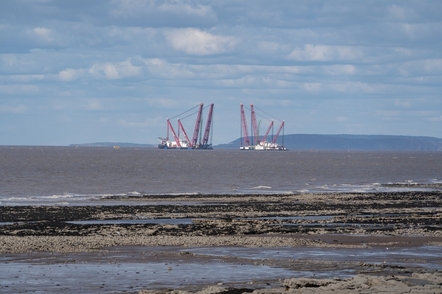Aspiration to deploy new UK nuclear reactor every year a 'wish', not a plan
Notably stretching the target requires 'a credible pathway towards its delivery,' says committee
The British government is hoping to hit 24 gigawatts of nuclear generating capacity by 2050 as well as roll out a new nuclear reactor every year. But these targets are more of a "wish list" rather than the type of strategic framework you'd need to actually build such capacity, according to a parliamentary committee.
The Science, Innovation and Technology Committee published its findings this week, warning the "stated aim" of 24GW via nuclear, while laudable, is overly ambitious as it "equates to three times current nuclear capacity, even before plant retirements, and it is almost double the highest nuclear installed capacity the UK has ever achieved." The MPs said this would "require substantial progress on technologies, financing, skills, regulation, decommissioning and waste management."
Among other recommendations, it asked government to outline clearly which technology it intends to back, what amount of capacity would come from the current reactor fleet, and some detailed figures of projected energy production from nuclear for the years leading up to 2050.
"Setting a notably stretching target requires a credible pathway towards its delivery."
Some background
The UK is a nuclear pioneer, opening the world's first commercial nuclear power station in the form of the Calder Hall nuclear plant, in Sellafield, northwest England, back in 1956, following 1955's "A Programme of Nuclear Power" whitepaper. But the UK's approach since then has been "characterised by intermittency," said the House of Commons committee, which took evidence from scores of witnesses in the months after the inquiry was opened in December 2022.
Between 1956 and 1979, 17 nuclear power stations were approved in the UK: 10 Magnox and seven advanced gascooled reactor (AGR) plants. There was then an eight-year gap before pressurized water reactor plant Sizewell B was approved in 1987. That plant came online in 1995.
A full 21 years later, in 2016, the next nuclear new build was approved: the European pressurized reactor (EPR) at Hinkley Point C. The plant is only due to come online in 2027.
Mind the gap
Nuclear capacity in the UK currently sits about 5.5 GW and contributes around 15 percent of the country's electricity needs. The report noted this will fall "substantially by 2028, when all plants bar Sizewell B are scheduled to come to the end of their lives."
It added: "Even when Hinkley Point C comes online, nuclear capacity will remain below current levels because of the expected retirements."
As of spring 2023, the UK has nine operational reactors in five power plants, eight of which are expected to be permanently shut down by 2028, leaving a capacity of around 1.2 GW.
The report included this table, summarizing the UK's current civil nuclear reactor fleet:
| Location | Reactor technology | Reactor generation | Capacity (MWe) | First power | Expected shutdown |
|---|---|---|---|---|---|
| Hartlepool (two reactors) | Advanced gas-cooled Reactor (AGR) | Generation II | 595 and 585 | 1983 and 1984 | 2026 |
| Heysham I (two reactors) | AGR | Generation II | 580 and 575 | 1983 and 1984 | 2026 |
| Heysham II (two reactors) | AGR | Generation II | 610 and 610 | 1988 | 2028 |
| Torness (two reactors) | AGR | Generation II | 590 and 595 | 1988 and 1989 | 2028 |
| Sizewell (B) | Pressurized Water Reactor (PWR) | Generation II | 1198 | 1995 | 2035 |
Source: Nuclear Energy (Financing Bill) 2021–22, Briefing Paper CBP9356, House of Commons Library, January 2022; EDF energy, Nuclear reactor lifetime management, accessed March 2023
The main pain point? Nuclear engineering is hugely complex and hugely expensive. So we're not talking about the kind of timelines that are going to make any one government look good. A successful strategy would need to be "designed to go beyond the lifetime of any single government if it is to break out of the decades-long intermittency of UK nuclear energy policy," the committee said.
The report noted the committee had grilled witnesses across the nuclear industry and that their "repeated requirement" was for a "much clearer and more concrete strategic plan than currently exists."
The authors went on to suggest that such a plan "could involve new gigawatt-scale nuclear power, small modular reactors (SMRs) and advanced modular reactors (AMRs), and further development of nuclear fusion."
Speaking about AMRs specifically, the committee noted that they "offer important advantages in terms of cost and the potential for cogeneration. But if they are to advance, the research and development needs to move from the desk and the lab towards demonstrators, and this will require the government to make decisions as to which technologies to fund."
The report said both SMRs and AMRs are expected to be quicker and cheaper to build than current buildouts, but noted that neither of the technologies have been deployed commercially, and that proposed cost savings including cost of construction and cost per megawatt-hour remain unknown. The cost of financing SMR and AMR builds is also "unknown, compared to gigawatt reactors."
- The AI arms race could give us the cool without the cruel
- Brits negotiating draft deal to rejoin EU's $100B blockbuster science programme
- UK's dream of fusion power by 2040s will need GPUs
- Caltech claims to have beamed energy to Earth from satellite

Spot the dog? No, we couldn't either because Spot is a robot employed by United Kingdom Atomic Energy Authority
READ MOREThe 24 gigawatt target was set by former UK PM Boris Johnson back in April last year in the wake of Russia's invasion of Ukraine, amid worries about the security of imported fossil fuels. The predicted shift toward electricity as the primary form of energy has also played its part as the world looks to decrease its reliance on fossil fuels and plug in its cars.
Basically, the government needs to quickly decide which tech to back, said the committee, noting the UK had a shortage of nuclear skills. Workers in the sector, numbering about 65,000, will "need to more than double," according to the report.
The report also recommended a Nuclear Strategic Plan that spells out "how the current reactor fleet, through life extensions, will contribute to the government's ambition of 24 GW from nuclear by 2050."
The committee's words come a year after a House of Lords report, which found the UK's ambition to become a global science superpower was held back because there were no "specific, measurable outcomes," no delivery plan, a short-termist outlook, and "frequent policy changes."
The goverment responded today with the announcement of "Nuclear Skills Taskforce," which it said would "turbo charge skills activity" in the nuclear sector. Simon Bollom was appointed as the taskforce's chair. It was a joint press release between the MoD and the department for Energy Security and Net Zero, so along with talking up the provision of "cleaner, cheaper and more secure energy," the announcement also positioned nuclear power as "crucial for Britain's military capabilities."
"Our Vanguard and Astute submarines, and from the early 2030s the new Dreadnought Class, use nuclear technology, keeping the nation safe every minute of every day," it continued. Bollom is the former CEO of Defence Equipment and Support and is currently on the Board of the Submarine Delivery Agency.
The UK is far from the only government to fall prey to short termist thinking. Germany wandered into its (admittedly planned) own goal nuclear switch-off earlier this year during an unprecedented energy crisis, but not before economy minister Robert Habeck, a member of the anti-nuke green party, amazingly suggested the country could potentially keep its last nuclear plant working, but only as an "emergency reserve." Nuclear engineers claimed they had to explain that you can't just switch a nuclear plant off and on again, but Habeck claimed he had been misunderstood.
Meanwhile, Germany has been criticized by France's energy minister, Agnès Pannier-Runacher, for apparent hypocrisy for importing nuclear energy from France despite rejecting EU legislation on nuclear energy. "Germany risks becoming more and more dependent on its neighbors for nuclear energy," she told German newspaper Handelsblatt earlier this month.
Germany has acknowledged its oversized reliance on Russian gas, however, with the government last year increasing its stake in Uniper SE to 99 percent, taking the historic step of fully nationalizing the country's biggest gas importer.
One country that's very good at planning ahead, at least in terms of infrastructure, transport and water management, is the Netherlands, which has 10-, 20- and 30-year-long outlines for continued investment in its super-efficient infrastructure. That said, looking after bridges, tunnels and locks, and ensuring proper flood risk management, makes a lot of sense when one-third of your landmass sits beneath sea level. "My house is underwater!" – an issue that truly cuts across party lines. ®


